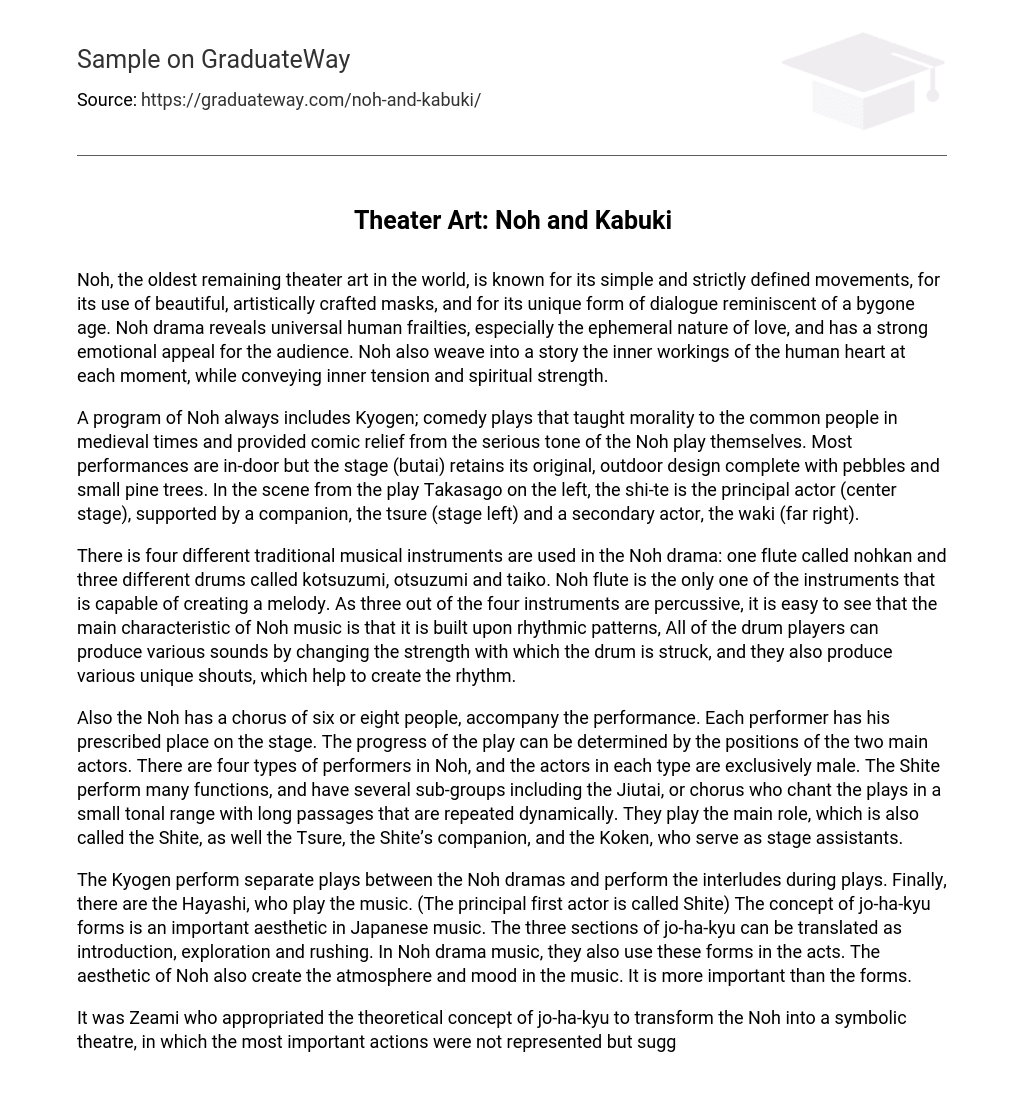Noh, the world’s oldest remaining theater art, is renowned for its elegant and precise movements, its utilization of exquisitely designed masks, and its distinctive style of dialogue that evokes a bygone era. Noh drama explores timeless human vulnerabilities, particularly the fleeting essence of love, and captivates the audience with its intense emotional impact. Additionally, Noh expertly integrates the intricacies of the human soul into each narrative, effectively conveying inner turmoil and spiritual resilience.
Noh, a traditional Japanese performing art, incorporates both Noh plays and Kyogen. Kyogen plays were comedic in nature and used to impart moral lessons to the general population during medieval times. They served as a source of light-heartedness amidst the seriousness of Noh plays. While most Noh performances take place indoors, the stage itself, called butai, maintains its original outdoor design, complete with pebbles and small pine trees. In the depicted scene from the play Takasago, the shi-te, who is the lead actor in the center stage, is accompanied by a tsure on the left side of the stage and a waki on the far right side.
There are four traditional musical instruments used in the Noh drama: the nohkan flute, kotsuzumi drum, otsuzumi drum, and taiko drum. The nohkan flute is the only instrument capable of creating a melody. With three out of the four instruments being percussive, it is evident that the main characteristic of Noh music is its reliance on rhythmic patterns. The drum players can produce different sounds by adjusting the strength of their strikes and also create unique shouts that contribute to the overall rhythm.
Additionally, in the Noh theatre, there is a chorus consisting of six to eight individuals that accompanies the performance. Each performer has their designated position on the stage, and the progression of the play can be determined by the positions of the two main actors. The Noh theatre encompasses four types of performers, all of whom are exclusively male actors. Among these types, the Shite performers hold various functions and possess sub-groups like the Jiutai, which is responsible for chanting the plays with a limited tonal range and repeating lengthy passages in a dynamic manner. The Shite performers undertake the central role, also referred to as the Shite, as well as play the Tsure, who serves as the companion to the Shite, and the Koken, who act as stage assistants.
The Kyogen perform separate plays between the Noh dramas and play interludes during the plays. The Hayashi, who play the music, are also included. (The main first actor is called Shite) The jo-ha-kyu forms are a significant aesthetic in Japanese music. These forms consist of three parts: introduction, exploration, and rushing. In Noh drama music, these forms are also employed during the acts. The atmosphere and mood of the music in Noh plays are primarily influenced by its aesthetic rather than the forms themselves.
Zeami was the one who took the theoretical concept of jo-ha-kyu and used it to transform Noh into a symbolic theatre, where important actions were suggested rather than directly represented. Kabuki, which means songs, dance, acting, also has its origins in Chinese-influenced sarugaku performance. Originally, Kabuki started as dances performed by women in Kyoto during the early 17th century. Their performances caused such a sensation that they were banned by the Tokugawa Shogunate. Subsequently, men took over the dances, and those performances evolved into the Kabuki we know today.
Kabuki plays, which mostly originated in the 17th and 18th centuries, gained immense popularity among the general public as they combined vibrant costumes, extravagant sets, captivating stage effects, and exemplary performances by highly skilled actors. Kabuki can be seen as Japan’s equivalent of the Broadway musical as it heavily focuses on dance, stylized singing-like dialogue, and intriguing tales of love, loyalty, honor, and betrayal. Despite being exclusively performed by men even today, Kabuki remains a beloved traditional form of entertainment that continues to impact contemporary Japanese theater and dance.
Despite the rising popularity of Kabuki, young male actors temporarily replaced women on stage. However, this practice lasted only two decades. Eventually, only adult men were granted permission to perform in Kabuki, and the art form has remained largely unchanged until today. Kabuki incorporates two categories of instruments: melodic and percussion. The melodic section encompasses instruments like shamisen, koto, kokyu, shakuhachi, nokan, and takebue. The percussion section includes gaku-taiko, okedo, hyoshigi, and more.
The entire ensemble can perform together, or they can perform in smaller groups, with certain players taking on the responsibility of solo performances. The main shamisen player is in charge of coordinating the music with the dancers. The hayashi ensemble, consisting of taiko, ko-tsuzumi, o-tsuzumi, and nohkan, originates from Noh theatre. It serves as the foundation for the debayashi and is also included in the geza. The geza is used to enhance the action at various points during a kabuki play. The geza ensemble is hidden from view in a small room behind a grille stage on the right side.
It is comparable to a sound effects booth, but its role is more advanced than simply choosing basic “noises off”. Kabuki drama places great importance on music, which is meticulously structured. Similar to many forms of Japanese music, there is minimal improvisation. The music serves multiple functions, such as narrating the story, accompanying the dances, and enhancing the stage performance. Kabuki is presented in comprehensive day-long programs that follow the jo-ha-kyu concept, which is also found in Noh.
Each play’s structure, scenes’ structure and actors’ actions are governed by this concept. A full-length play consists of five acts. Kabuki is more popular than Noh drama due to the majority of the audience’s welcome and support. Noh drama became famous because it was able to portray the original terms of the shogunate and the imperial sponsorship. Kabuki different characteristics include rhyming lines, wonderful dancing, luxurious costumes, makeup, mining, and other-designed accessories.





